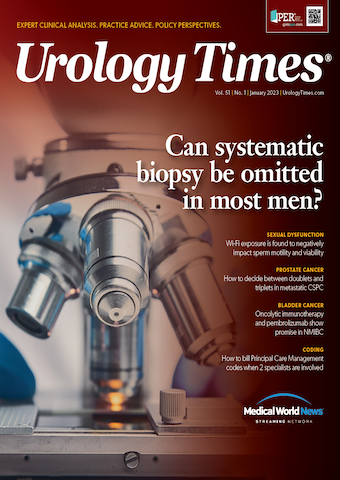Publication
Article
Urology Times Journal
Can systematic prostate biopsy be omitted in most men?
Author(s):
"It’s apparent that reducing overdiagnosis alone may not necessarily reduce over treatment, and that separate and specific focus on prevention of over treatment is still needed," Badar M. Mian, MD, writes.
Badar M. Mian, MD, writes, "Utilization of screening tools such as PSA test requires balancing the tradeoffs of detecting clinically insignificant cancers and misdiagnosing clinically significant ones."

Despite having been the predominant mode of population-based screening for early detection of prostate cancer for nearly 3 decades, the prostate-specific antigen (PSA) test remains controversial. Several trials have demonstrated improvement in prostate cancer–related mortality in men undergoing screening and systematic prostate biopsies, but this improvement is associated with a high rate of overdiagnosis, ie, detection of clinically insignificant prostate cancer.
The various attempts made to reduce overdiagnosis via PSA-related and other serum- and urine-based biomarkers have met with mixed results. More recently, multiparametric MRI of the prostate is being used in men with an elevated PSA level in order to improve the accuracy of the biopsy procedures. At present, it is widely believed that prostate biopsy schemes should include targeted as well as systematic biopsy samples to avoid missing clinically significant, MRI-invisible prostate cancer. The Swedish population-based trial, GÖTEBORG-2 (ISRCTN94604465), was designed to evaluate whether omitting systematic biopsy in men with an abnormal MRI and performing targeted biopsy of only MRI-detected lesions could reduce the risk of detecting clinically insignificant prostate cancer while still detecting clinically significant disease.1
Of the 38,775 men aged between 50 and 60 invited to undergo PSA testing between September 2015 and January 2020, 19,780 had a PSA test. The reference group (5,994 men) included men undergoing PSA testing, and if their PSA level was ≥ 3 ng/mL, an MRI of the prostate was performed followed by systematic biopsy as well as targeted biopsies if a lesion was noted on the MRI.
The experimental group of 11,986 men with PSA level of ≥ 3 ng/mL underwent a prostate MRI followed by targeted biopsy only of the MRI-detected lesions. Biopsy technique included systematic transrectal ultrasound-guided biopsies (10 to 12 cores from the peripheral zone) and targeted biopsy using visual estimation or cognitive fusion (4 cores). The primary outcome of interest was the detection rate of clinically insignificant prostate cancer (Gleason score 3+3, Grade Group 1), and the secondary outcome was clinically significant prostate cancer (Gleason score 3+4 or higher).
In this study, about 7% of participants in both groups had PSA levels ≥ 3 ng/mL, including less than 1% who had a PSA level of 10 ng/mL or higher. Of the participants who had an elevated PSA, 95% underwent MRI. Of those who had an indication for biopsy, 86% (348 of 405) in the reference group and 90% (300 of 335) in the experimental group underwent biopsy.
On a population level, 66 of 11,986 participants in the experimental group (0.6%) and 72 of the 5,994 participants (1.2%) in the reference group were eventually diagnosed with clinically insignificant prostate cancer (relative risk, 0.46; 95% CI, 0.33 to 0.64; P< .001). Clinically significant cancer was detected in 110 participants (0.9%) in the experimental group and 68 (1.1%) in the reference group (relative risk, 0.81; 95% CI, 0.60 to 1.10).
In the reference group, clinically significant cancer was detected by systematic biopsy alone (missed by the MRI) in 10 men. If MRI results had been disregarded and only systematic biopsies performed, clinically significant cancer would have been missed in 10 of the 68 men (15%). This represents the unique contribution of MRI-targeted biopsies in the group. In the experimental cohort, targeted biopsies alone diagnosed cancer in 128 participants, with 72 (56%) demonstrating Gleason score of 3+3. Most of these men with low-risk cancer underwent repeat confirmatory systematic biopsy, which resulted in 16 (26%) men being upgraded to Gleason score 3+4. This represents the missed opportunity of MRI-targeted only approach.
Overall, the percentage of men undergoing prostate biopsies (and total cores obtained) was significantly lower in the experimental group (363/796: 46%) than in the reference group (348/405: 86%). However, the incidence of severe adverse events after prostate biopsy was similarly low in both groups. Postbiopsy antibiotics for urinary tract infection were prescribed to 10 patients, including 3 (0.03%) in the experimental group and 7 (0.1%) in the reference group. Three participants required hospitalization after biopsy: 1 (0.008%) in the experimental group and 2 (0.04%) in the reference group .
Interestingly, twice as many patients underwent treatment (instead of active surveillance) for low-risk cancer in the experimental group (29%) when compared with the reference group (14%). In hypothetical cohorts of 10,000 men meeting the inclusion criteria in each of the experimental and the reference groups, the incidence of low-risk disease in the MRI-targeted alone experimental approach would yield 60 cases of low-risk cancer, and the standard pathway of systematic and targeted biopsies would yield 120 cases of low-risk disease. Surprisingly, although the low-risk cancer detection rates differ significantly, a similar number of men with low-risk cancer would be treated (i.e. over treatment) in each group: 17.4 men in the experimental and 16.8 men in the reference group.
Utilization of screening tools such as PSA test requires balancing the tradeoffs of detecting clinically insignificant cancers and misdiagnosing clinically significant ones. The goal is to avoid potential harm from screening, including overdiagnosis of otherwise inconsequential cancers, and to reduce the rate of overtreatment.
Although the psychological and financial benefits of avoiding the label of “prostate cancer” (especially low-risk) for the patient are demonstrable, the risk of misclassifying 1 in 4 (or 5) men with potentially clinically significant cancers as low-risk must be considered carefully. The surprising finding that despite meeting the primary outcome of lower detection rate of insignificant prostate cancer (by 50% in the experimental group), there was no decrease in the over treatment of men with low-risk prostate cancer. It’s apparent that reducing overdiagnosis alone may not necessarily reduce over treatment, and that separate and specific focus on prevention of over treatment is still needed.
Reference
1. Hugosson J, Månsson M, Wallström J, et al. Prostate cancer screening with PSA and MRI followed by targeted biopsy only. N Engl J Med. 2022;387(23):2126-2137. doi:10.1056/NEJMoa2209454





























